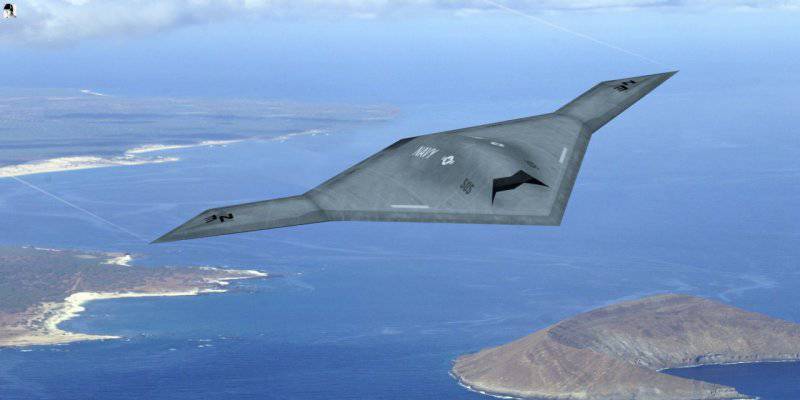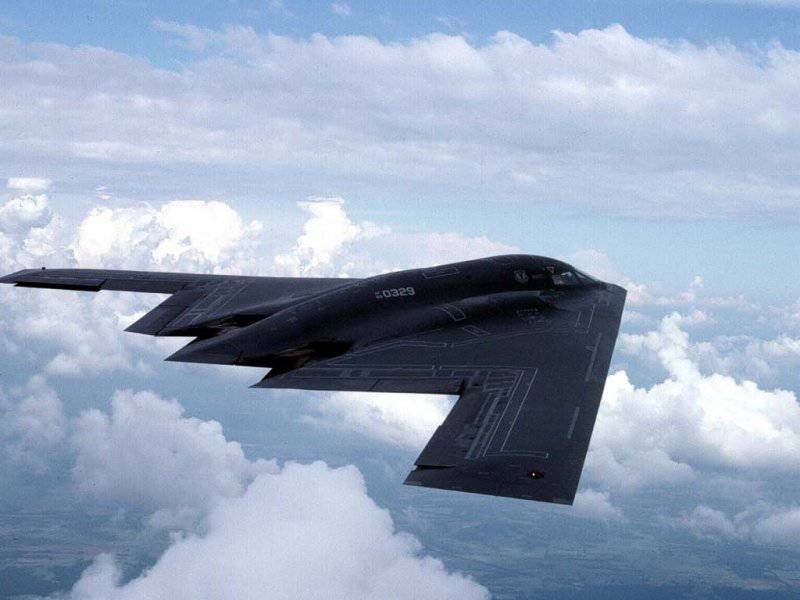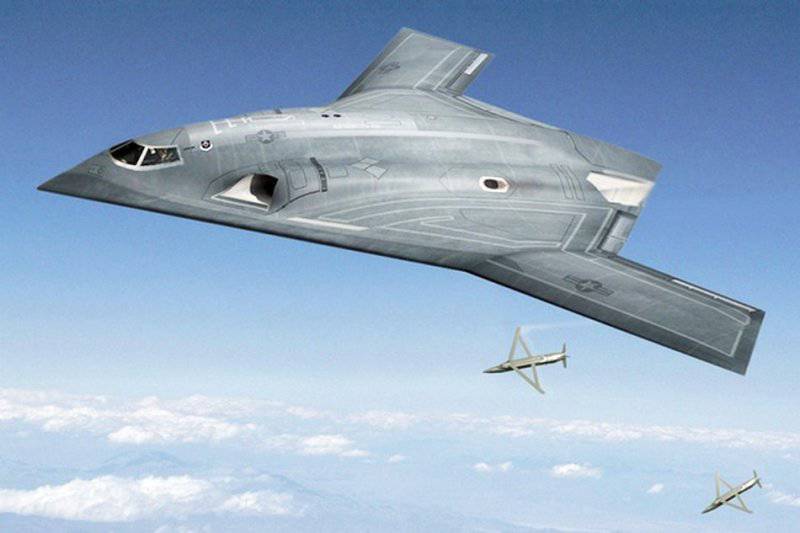US programs to create new strategic bombers
It should be noted that the Pentagon began to consider the creation of a promising bomber at the beginning of the last decade. First, the features of the use of such aircraft in modern wars, including local ones, were studied. Then a list of requirements was formulated and the 2018 Bomber program was launched (“2018 Bomber of the Year”). It was assumed that the new strategic bomber will make its first flight in the middle of the tenths and by the end of the decade will be adopted.
In the middle of the two thousandth, it was claimed that the aircraft, created by the program 2018 Bomber, would be similar to the currently operated B-2. In the new project, it is also planned to use stealth technology that will help the subsonic aircraft to overcome the modern and future anti-aircraft defense of a potential enemy. In addition, in the middle of the last decade, some sources mentioned the possible name of a promising aircraft - B-3.
How information about the name of the bomber corresponded to reality is unknown. However, by the end of the two thousand years, the Pentagon had updated some of the requirements for the aircraft, and also announced a new name for the program: now it did not mention the year of the proposed adoption. According to representatives of the US military, the result of the NGB project (Next-Generation Bomber - “Next Generation Bomber”) should be the creation of a promising, subtle, inconspicuous aircraft with an average take-off weight and long range. Early assumptions about the creation of a super- or even a hypersonic bomber, as well as versions of the transition to unmanned technology, received an official refutation. The reason for this was the development of technology, as well as the requirements regarding the timing of development and the start of construction of aircraft.
Requirements for the NGB aircraft are constantly adjusted. They regularly added new items to them, as well as changed existing ones. As of the end of the last decade, the Pentagon required developers to create a medium-weight bomber capable of using any existing guided and unmanaged weapon. In addition, he was required from a long range and the possibility of many hours of duty in a given area in readiness to strike at orders. In view of the characteristics of the air component of the US nuclear triad, the possibility of equipping NGB with cruise missiles with a nuclear warhead was seriously considered.
At the beginning of 2008, an event occurred that could be considered decisive for the subsequent work on the project. Boeing and Lockheed Martin have agreed to jointly participate in the NGB project. Due to the absence of other such large and powerful participants capable of comparing with a consortium of Boeing and Lockheed Martin, these companies began to call the winners of the future competition for the development of a technical project. However, subsequent events have refuted such assumptions. It was expected that at the end of 2009, the customer would issue final requirements for the NGB aircraft and begin the tender. However, in mid-2009, US Secretary of Defense R. Gates announced that there were some problems that would have to change the project schedule. Economic problems and some issues related to international treaties in the field of nuclear weapons, have led to the fact that the NGB project could no longer produce results by the 2018 year.
The economic side of the NGB project at the end of the last decade is of particular interest. Seeing the frankly unsuccessful financial aspects of the B-2 project (each of these aircraft cost 2 more than a billion dollars, which made it possible to build only an 21 machine), the US military demanded from the outset potential developers of the NGB project to reduce the price of the finished aircraft. It was expected that one aircraft of the new model would cost no more than 500-550 million dollars. While preserving the financial capabilities of the past years, the Pentagon planned to order 120 such bombers for combat service and 55 for reserve and use as training machines.
However, at the end of the two thousand years, Congress demanded a reduction in military spending, which had corresponding consequences. In the summer of 2010, Pentagon spokesman Lieutenant General F. Breedlove announced that he had stopped work on the NGB project. According to him, now the Air Force, the military department and the aviation industry intend, using the available experience on the latest projects, to develop and put into operation a family of long-range strike aircraft. The new project was named LRS-B (Long Range Strike Bomber - “Long Range Bomber”).
During the first months after the announcement of the start of the new project, the Pentagon representatives made several interesting statements. A number of statements by military commanders and officials suggested that the LRS-B project was in fact a slightly revised, taking into account some of the new NGB requirements. As before, the promising aircraft should resemble the Northrop Grumman B-2, but have a significantly lower cost.
In the spring of 2011, it became known that over the next 10-15 years at least 80 new bombers could be built. The maximum number of aircraft of the new type required by the air force was determined at the level of 100 units. The cost of each aircraft was supposed to be kept at the level indicated in the NGB project.
In the same year 2011, during the development of the military budget for the next year, new interesting information was published. As it turned out, together with the LRS-B bomber it was planned to create modifications intended for reconnaissance, jamming, etc. tasks. Project activities planned for 2012 year are estimated at about 200 million dollars. At 2013 fiscal year, project development costs were estimated at 290 millions. In total, it is planned to spend 3,7 billion dollars for the development of the bomber and its modifications over five years. The total cost of the program, including the construction of a large series of aircraft, was estimated at 40-50 billions.
As follows from News, appeared at the beginning of last year, work on the LRS-B project started in the fall or winter of 2011. According to reports, the development of outline designs on a competitive basis is still ongoing. The list of contest participants has not yet been published. Probably, the same companies that participated in the work on the Next-Generation Bomber, namely Northrop Grumman, Boeing and Lockheed Martin, are developing their LRS-B project options.
In May of the current 2013 of the year, the United States Air Force announced that the promising long-range bomber LRS-B should reach the state of initial operational readiness in the 2025 year. This means that the first flight of the new aircraft should take place at the end of the current decade or at the very beginning of the next. At the same time, US officials spoke about the approximate appearance of a promising bomber. As stated, it will resemble existing B-2, both externally and in some of its characteristics. In the basic version of the aircraft will be manned, but in the future does not exclude the possibility of creating an unmanned version. Some technical solutions providing such an opportunity are supposed to be laid already in the early stages of design.
Almost all information about the appearance of the aircraft LRS-B is classified. The latest data on the possible characteristics of a promising bomber were published at the beginning of 2011, and therefore, probably, they became outdated and no longer correspond to reality. From the information, announced more than two years ago, it follows that the LRS-B bomber will be made according to the “flying wing” scheme. This will allow it to have a relatively low visibility for radar detection equipment, as well as provide good flight characteristics. Flight range without air refueling was estimated at 9000 km. Payload - no more than 12 tons. It was argued that the new aircraft, depending on the tactical situation, could use both nuclear and conventional weapons of various types. Finally, in the future, the long-range bomber should become the base for the reconnaissance aircraft, the jammer, and also, possibly, for the air command center.
A promising long-range bomber LRS-B should become a kind of transitional link from modern American technology of its class to the newest aircraft, which is supposed to be developed during the 2037 Bomber program (2037 Bomber of the Year). Work on this new project will begin no earlier than the twenties. For obvious reasons, all information about the next generation of US strategic bombers is limited to only a few exemplary statements that can be confirmed or refuted in the future. It is assumed that the 2037 Bomber of the Year will replace the aircraft of all types currently in service, including the B-52H, which are supposed to remain in service until the beginning of the 1940s. The new bomber will be able to fly at supersonic speeds and use advanced aviation weapons, including nuclear ones. With future progress in this area, the 2037 Bomber can be the first aircraft in its class to perform combat missions without crew on board. This does not exclude the possibility of saving pilots when using equipment for remote control or creating a special manned version.
Since the 2037 Bomber has been operating for about a quarter of a century before the proposed start of operation, all information about this project is purely presumptive. Moreover, it cannot be excluded that the next project of a strategic bomber will be subject to serious adjustments or even be closed in favor of the new program, as it was with the 2018 Bomber of the Year.
As you can see, the United States has big plans for the creation of new long-range bombers. They are going to create a new project that can meet the requirements that are quite ambitious for the time being and at the same time save on both the development and the construction of mass-produced aircraft. In addition, there are already some considerations concerning the further development of strategic aviation. In fact, to date, the Pentagon has created a rough plan of action, designed for the next 25-30 years. Of course, the late stages of this plan, related to the 2037 Bomber project, cannot be called a clear program of action, but steps for the near future have already been defined. This means that in the middle of the next decade, the US Air Force will be replenished with new LRS-B aircraft.
However, such optimism has a downside. First of all, these are financial aspects of the project. Despite existing restrictions on the cost of new aircraft incorporated into the project, the actual values of this parameter can go beyond all reasonable limits in 10-12 years. A similar situation has already been observed with several of the latest American projects of fifth-generation fighter aircraft, which in the end turned out to be much more expensive than originally planned. No one can guarantee that the LRS-B project will not suffer the same sad fate.
The second feature of the LRS-B and 2037 Bomber projects, which is not very pleasant for the US air force, lies in the timing of their implementation. The first of the aircraft will go to the troops not earlier than in 10-12 years, and the second - in 12-15 years. Thus, for the next decade (with the actual work consistent with the current schedule), the Boeing B-52H Stratofortress will remain the main strategic bomber missile carrier of the United States Air Force, capable of using a wide range of missile and bomb weapons. It is worth recalling that the newest aircraft of this type was built in the early sixties of the last century.
On the materials of the sites:
http://flightglobal.com/
http://aviationweek.com/
http://airforce-magazine.com/
http://defensenews.com/
http://janes.com/
http://globalsecurity.org/



Information